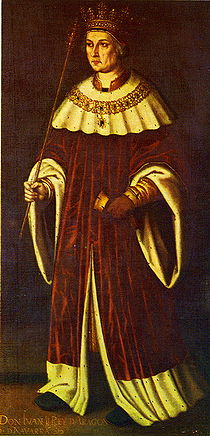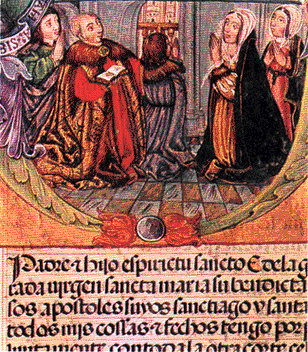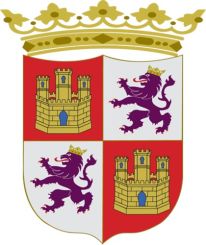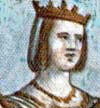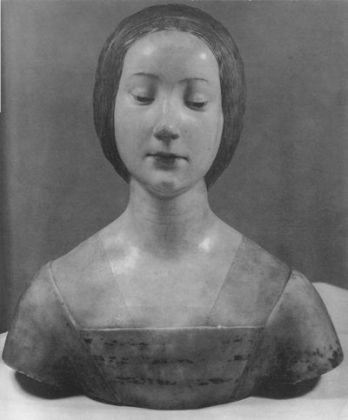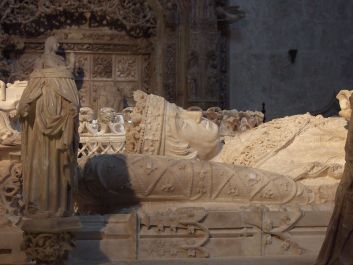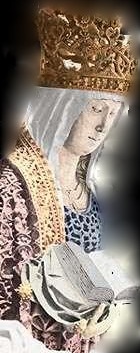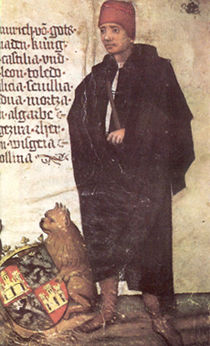Queen Katherine's Family
Jump to navigation
Jump to search
| |
| Katherine and her parents 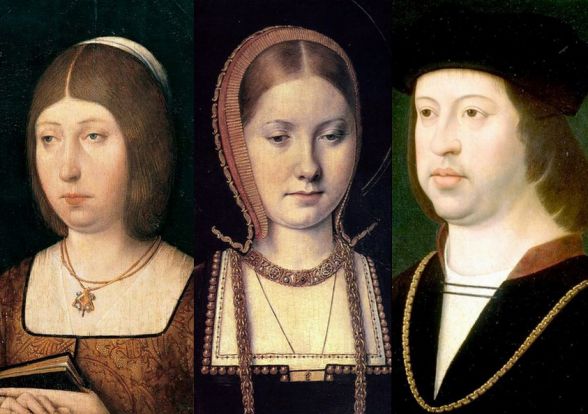 Katherine's siblings 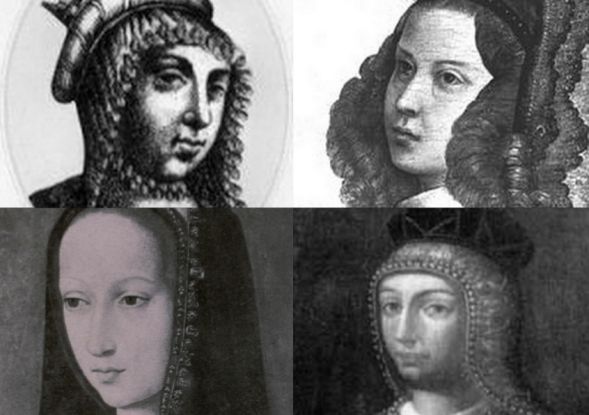 |
Queen Isabella I of Castile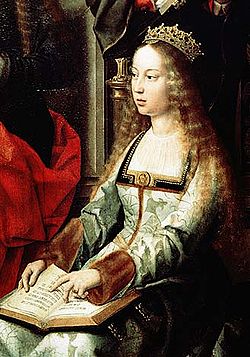 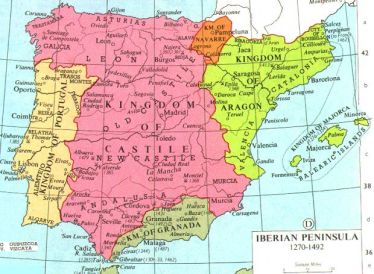 Spain in 1492 | Queen Isabella of Castille was born on April 22, 1451 in Madrigal de las Atlas Torres, Castile. She was the daughter of John II of Castile by his second wife Isabella of Portugal. She was also half sister to Henry IV who succeeded to the Castilian throne in 1454. Isabella had a younger brother, Alfonso, born in 1453. Her father died when she was three, and her mother, aged only 22, retired from Court with her children to the small town of Arevalo, where she became increasingly mentally ill. When Isabella was eleven, her brother Henry summoned her to Court to be godmother to Princess Joanna, who was widely rumoured to be the product of his wife's adultery with a prominent courtier. Henry's weak rule sparked a number of rebellions: by 1466, these used Isabella's brother Alfonso as a figurehead and Isabella was torn between his claims and those of Henry, whom she regarded as the rightful king. She was also forced to sidestep Henry's efforts to marry her off to a series of unwanted bridegrooms: she was saved from one of these, a drunken, middle-aged lecher named Pedro Giron, by his sudden death on the way to the wedding. On the death of Alfonso in 1468, Isabella initially considered making a bid for the throne but then wisely came to a compromise with Henry rather than seeking to immediately become Queen. She was aware that as an unmarried teenaged girl, the support which she could attract would be limited.. Henry recognised her as his heiress and she promised in turn not to marry without his permission. But neither side trusted the other, and Isabella knew that she needed to find a husband quickly to bolster her claims. At seventeen, Isabella was a tall, pretty girl with the blue eyes and red-blonde hair of her Plantagenet ancestors. Unsuprisingly, she had many suitors, the most serious of which were King Alfonso of Portugal; Charles, Duke of Berri, brother of the King of France; Richard Duke of Gloucester (the future Richard III); and her second cousin Ferdinand of Aragon. Unusually for a fifteenth-century woman, Isabella got to choose. The favourable reports of the good looks, courage and intelligence of Ferdinand convinced her to choose him, although she was also aware that he was only sixteen, he already had a terrible reputation as a womaniser. As he was also, after his father, the nearest male heir to the throne of Castile, it mean that they could join their claims together. In order to escape arrest by her brother's agents, who had learned of her proposed marriage, Isabella was forced to flee to Valladolid. Ferdinand had an even more eventual journey: travelling in disguise as a servant, he was almost killed by a stone thrown by a sentry at the froniter town of Burgo de Osma Meeting for the first time in secret two days before their wedding, Ferdinand and Isabella seemed to have formed an instant attachment. The couple married on October 19, 1469, on a papal dispensation which turned to have been forged by Ferdinand's father and the Archbishop of Toledo.. Isabella was immediately disinherited by a furious Henry, who conferred the succession on his alleged daughter Joanna. For the remainder of Isabella's life and reign, see below |
King Ferdinand II of Aragon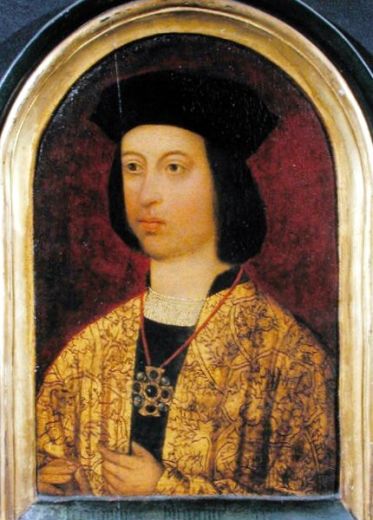 Ferdinand of Aragon as a young man 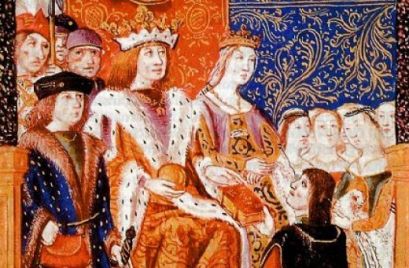 Ferdinand and Isabella with their courtiers 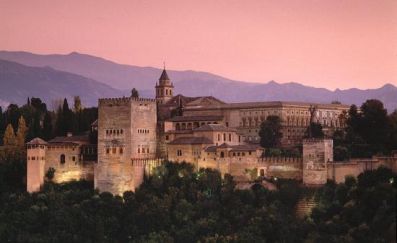 The Alhambra, Granada, last stronghold of the Moors in Spain 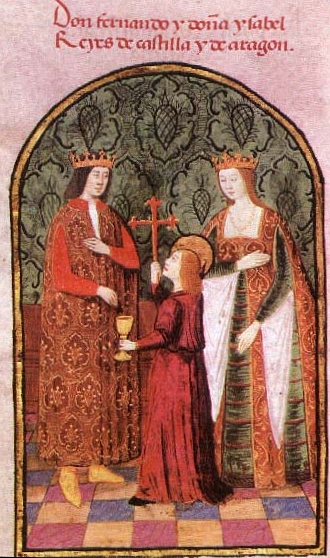 Ferdinand and Isabella in about 1486 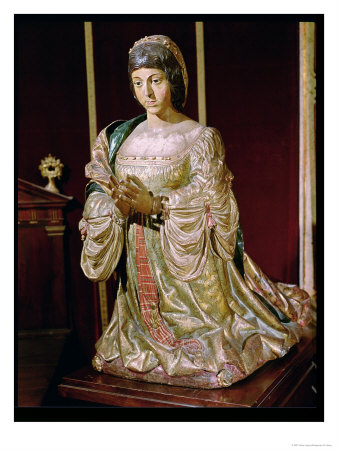 Statue of Isabella in the Capilla Real, Granada 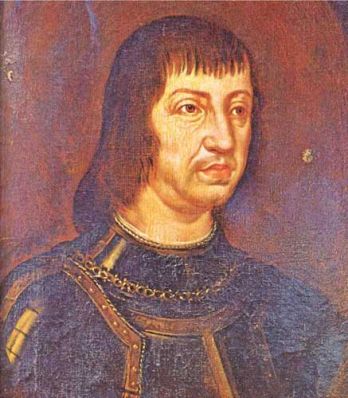 Ferdinand of Aragon 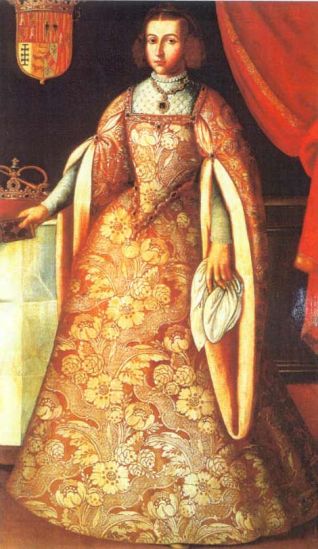 Katharine's stepmother, Germaine de Foix (1488 - 1538) 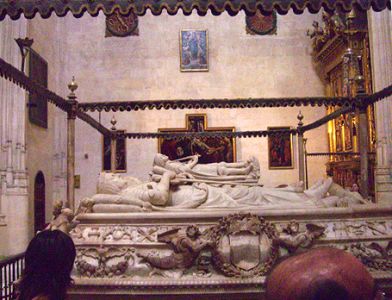 Tomb of Ferdinand and Isabella (with that of Phillip and Juana in the background), Capilla Real, Granada | Ferdinand II of Aragon was born on March 10, 1452, in the small town of Sos, Aragon, the son of John II of Aragon by his second wife, the Castilian noblewoman Juana Enriquez. As the younger son of a younger son, he appeared to have little prospect of inheriting the throne, but when his uncle Alfonso V died without legitimate heirs, his father John became King of Aragon at the age of sixty. John was on bad terms with his eldest son Charles, and refused to ackowledge him as heir to the throne. This resulted in unrest in Catalonia, and when Charles died in 1461, leaving his nine year old brother as heir, iit developed into outright civil war. Queen Juana succeeded in obtaining the recognition of her son as heir, but was forced to flee to Gerona, where she and her nine year old son were besieged in Gerona by a rebel army for two months. John succeeded in resuing his wife and son with the help of his son-in-law Gaston de Foix, but at the price of pawning the provinces of Roussillon and Cerdagne to France. The rebellious Catalans offered the throne to a series of pretenders, whilst Aragon and Valencia remained loyal to the King. Placed by his faher at the head of the Aragonese forces, the twelve year old Prince Ferdinand won a notable victory over the forces of the pretender Pedro of Portugal at the Battle of Calaf on 28th February 1465. As the chronicler Pulgar said, 'throughout his childhoof, he (Ferdinand) was brought up in wars, where he underwent many hardships and dangers.' Another, more dangerous pretender arose, the French-backed John of Lorraine. As his father went blind and his mother succumbed to cancer, the young Prince faced increasing responsiblities as Governor of Aragon and leader of the army. At fifteen, he was described by a contemporary writer as 'a good knight - strong, handsome, brave and very sure of himself'. John turned to diplomacy to isolate his enemies, and arranged for Ferdinand to marry the Princess Isabella. This took place on 19th October 1469. Greatly aided by Ferdinand's diplomatic and military skills, Isabella spent the next five years building up support amongst the Castlilan nobility and towns. She gave birth to a daughter, Isabella, in 1470 and in 1472 obtained a valid dispensation for her marriage from the papal legate, Cardinal Borgia (the future Pope Alexander VI). When Henry died on 11th December 1474, Isabella had herself proclaimed queen. She was immediately challenged by Joanna and her supporters, who obtained the backing of King Alfonso of Portugal, her uncle and later fiance. The civil war that followed lasted five years, but the outcome was not in doubt after Ferdinand's victory over Alfonso at the Battle of Toro on 1st March 1476. The Treaty of Alcacovas which settled the war provided for the marriage of Princess Isabella to the heir of Portugal. Ferdinand and Isabella agreed a power-sharing deal by which each could wield power in Castile jointly and severally. After his father's death in 1479, Ferdinand extended the same powers to Isabella in Aragon. Despite their different personalities, or 'the contrast of character between the uncompromising, devout and chaste Isabella and the wordly, flexible and frequently unfaithful Ferdinand' (Henry Kamen), their equal partnership proved a great success. However, like other women of her time, Isabella had to turn a blind eye to her husband's frequent affairs (he had at least seven illegitimate children, all by different women), and no doubt gave good advice to Katharine on that score. Ferdinand and Isabella had five children who lived to adulthood, one son and four daughters. They were careful to present all their actions as being made jointly, to exclude any possibility of the nobility attempting to play one off against the other, to the extent that the chronicler Pulgar recorded that 'the King and Queen gave birth to a a daughter!' The young King and Queen faced an uphill struggle to restore order in Castile after the anarchy of Henry's reign, but succeeded in curbing the power of the nobility, boosting the power of the towns and restoring law and order. Although some writers have claimed that Katharine was brought up in Granada, she only spent a few months there, as the Spanish court was itinerent - in the thirty year reign of Ferdinand and Isabella, it travelled well over two thousand kilometres. The monarchs did more travelling than any other ruler in Spanish history, with the possible exception of the current King, their descendant Juan Carlos, who has the advantage of modern methods of transportation rather than going everywhere on horseback. This had the advantage of giving their subjects some sense of cohesion, as the kingdoms otherwise functioned internally as separate entities. The Moorish kingdom of Granada was still a separate state within the peninsula, but in 1481, the Moorish capture of Zahara sparked a war which would last for ten years. Ferdinand led the army and fought with great courage and Isabella organised supplies and men. Contrary to the opinions of some writers, she never led the army in battle, although she occasionally wore armour whilst reviewing the troops. Whilst the Spanish forces suffered some reverses in the early years of the war, their superior organisation, manpower and firepower meant that the outcome was never really in doubt. They were also aided by feuds within the Moorish royal family, which Ferdinand exploited with his usual skill. The young Katharine was present during the blockade of the city of Granada, which lasted from 1491 to the beginning of 1492. Granada officially surrendered on 6th January 1492. Under the terms of the surrender, the Moors were allowed freedom of worship. In 1478, Pope Sixtus IV granted permission for the establishment of an inquisition in Castile. This was not a new idea - Aragon already had an inquisition and previous tribunals had operated elsewhere, including southern France. The main purpose was to ensure the religious orthodoxy of the conversos, those who had converted from Judaism, many of whom clung to Jewish customs. By the standards of the time, the inquisition was not particularly harsh and the great majority of those found guilty of heresy were fined or penanced rather than executed. Due to concerns that the remaining Jews influenced their converso friends and relatives adversely, the Jews were expelled from all the Spanish kingdoms on 31st March 1492. Again this was not a new idea - Jews had previously been expelled from England, France and parts of Italy. About half converted to Christianity and around 80,000 left the country, although half of those later converted and returned. In the same year, Ferdinand and Isabella agreed to sponsor the Genoese sailor Columbus. His discoveries led to the expansion of the Spanish empire. In 1494, by the Papal Bull Inter Caetera issued by Alexander VI and the Treaty of Tordesillas, the Americas were divided between Spain and Portugal. Up until 1492, both Ferdinand and Isabella had concentrated primarily on solving Castilian problems and conquering Granada. Thereafter, Isabella was mainly occupied with church reform and Ferdinand with foreign policy. He gradually built up the best diplomatic service in Europe, which ensured that he was far better informed about his rivals and their plans than they were about him. After surviving a near-fatal assassination attempt in Barcelona on 7th December 1492 (which must have been extremely traumatic for the seven year old Katharine), Ferdinand successfully recovered the counties of Rousillon and Cerdagne from Charles VIII, who wanted a free hand to conquer Naples (Treaty of Barcelona, 19th January 1493). Naples was ruled by his brother-in-law and cousin, Ferrante I, but Ferdinand had never given up his own claims. He formed the Holy League in 1495, in which the Pope, Spain, the Holy Roman Empire, Venice and Milan combined together to drive the French from Italy. The marriages alliances of his children (see below) were designed to encircle the old enemy, France. In 1500, Ferdinand changed sides and allied with Louis XII of France to eject the illegitimate line of Aragonese kings from Naples and divide the kingdom between them. The erstwhile allies soon quarrelled, and war broke out in 1502. Initially, the French were successful but the Spanish army under Gonsalvo de Cordoba gradually wore them down and by the end of 1503, the entire kingdom was in Spanish hands. Ferdinand also increased his influence on the small kingdom of Navarre, ruled by descendants of his sister Eleanor. Ferdinand was at odds with Isabella over the government of Granada. He objected to the heavy-handed actions of Cardinal Cisneros, Archbishop of Toledo, which soon provoked a rebellion. Following the suppression of the revolt, all Moors who refused to convert to Christianity were expelled from Granada in 1501 and from Castile in 1502. The majority coverted, but with little sincerity. Ferdinand refused to implement the same policy in Aragon, where the Moors continued to enjoy freedom of worship until 1525. In 1503 Ferdinand and Isabella became heirs to the Eastern Roman Empire and thus Ferdinand became de jure Roman Emperor. By this time, Isabella's health was beginning to fail and she was increasingly worried by the mental health problems of her daughter and heiress Juana, wife of the Archduke Philip of Austria, Duke of Burgundy. By September 1504, it was clear that Isabella was dying of cancer. In her Will, she specified that Ferdinand should serve as Regent of Castile until her grandson Charles was twenty if Juana was 'unwilling or unable to rule' Isabella died at Medina del Campo on 26th November 1504 at the age of fifty three. She was a woman of great determination, resourcefulness, ability, and courage, but her piety was marred by bigotry and her resolution by inflexibility. She had proved that an able woman could rule successfully in a male-dominated world, a lesson which was not lost on her daughter Katharine and granddaughter Mary. Isabella's death left Ferdinand - and by extension, Katharine - in a very difficult position. Although he succeeded in persuading the Cortes of Toro to ratify his title of Regent in 1505, he faced opposition from the Archduke Phillip. Phillip had previously stated that Juana was insane, but he was now anxious to press her claims in an effort to win power for himself. With the Emperor Maximilian supporting his son's claims and Henry VII sitting on the fence, Ferdinand reversed his traditional policy and made an alliance with France (Treaty of Blois, 1505). Under the terms of the treaty, Ferdinand married Louis' niece, Germaine de Foix, who also had the advantage of possessing Andorra and a claim to the throne of Navarre. According the Venetian ambassador, he was no more faithful to her than he had been to Isabella. Their only son, John, died a few hours after his birth on 3rd May 1509. The support that Phillip gained from the Castilian nobility, who wanted a weak King so that they could wield more power, forced Ferdinand to withdraw from Castile in June 1506. Sailing to Naples, he spent seven months reorganising the administration of that kingdom before meeting Louis XII at a summit meeting at Savona. By this time, Phillip had died and Juana showed no inclination to exercise power, allowing Castile to fall into a state of anarchy. Ferdinand's return to the Regency in 1507 was generally welcomed by the nobles as well as the people, and after making an example of the rebellious Marquis of Priego, he had no further problems in establishing his control over Castile. He was now able to turn his attention to Katharine's situation in England (given the precariousness of his own position, it is difficult to see what more he could have done for her prior to that point). He made Katharine his ambassadress to England (the first female ambassador in recorded history) and made the remainder of her dowry available. Negotiations recommenced, although without significant progress until the young Henry took the throne. Ferdinand's adherence to the League of Cambrai (1508) , under which the majority of European powers joined together to crush Venice, brought him the return of the Neapolitan ports lost to the Republic in 1495, and the subsequent War of the Holy League extended Spanish influence into northern Italy. Spanish expansion in the Americas continued, and Florida was discovered by Ponce de Leon in 1513. In the same year, Niccolo Machiavelli used Ferdinand as a major role model in his famous political work, 'The Prince'. Between 1507 and 1509, many ports on the coastal strip of North Africa known as the Maghreb fell to Spain.However, the most important event of the last part of Ferdinand's reign was probably the conquest of Navarre. Navarre had been inherited by Ferdinand's great-niece Catherine and her husband Jean d'Albret. Louis XII had been inclined to support the rival claims of their cousin Gaston de Foix as a way of keeping them in line, but Gaston's death at the Battle of Ravenna (1512) meant tnat his claims passed to his sister Germaine, the wife of the French King's greatest rival. .Louis therefore made a defensive pact with them (Treaty of Blois, 1512). Anticipating this, Ferdinand had manipulated Henry VIII into sending an amy into Guienne under the Marquis of Dorset. What followed was 'one of the most extraordinary pieces of duplicity that history records' (Roger Merriman). Ferdinand published what he claimed was a precis of the Treaty of Blois, which had allegedly fallen into his hands when a secretary of the King of Navarre had been murdered by his mistress. The precis, however, was of a treaty that provided for an attack on Spain by France and Navarre rather than the purely defensive alliance of the actual treaty. Contemporaries were fooled by this- it would be four hundred years later before historians realised that Ferdinand had invented the entire stoy. With the attack on Navarre apparently justified and backed by the Pope, and France effectively rendered unable to support the Navarrese sovereigns due to the presence of Dorset's army, Ferdinand's army had little trouble in conquering the entire kingdom. John and Catherine fled to France. The Cortes swore allegiance to Ferdinand in 1513, and most of Navarre remains part of Spain to this day. By 1515, the foundations of the great Spanish Empire had been laid, and Ferdinand was able to declare to the Cortes of Burgos that 'in the past seven hundred years, the Crown of Spain has never been so great or so resplendent as it is now'. Increasingly ill with coronary disease, Ferdinand continued to travel throughout Spain. On a journey to Seville in January 1516, he apparently suffered a heart attack near the small village of Madrigalejo in Extramadura, and died there a few days later on January 23rd 1516 at the age of sixty three. Under the terms of his Will, the Spanish kingdoms were in practice inherited by his grandson Charles V, although Juana remained the theoretical soveriegn. The news of his death was concealed from Katharine until after the birth of Princess Mary on 18th February. Ferdinand was brave, clever, charming, resilient, witty and charismatic, but was also devious, unscrupulous, duplicitous, promiscuous and ruthless. For good or ill, his actions had shaped not just Spain but Europe at a critical turning point in history. |
Isabella Princess of Asturias;Queen consort of Portugal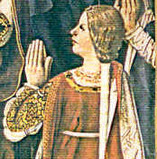 | Born in 1470, Isabella was the eldest child of Ferdinand and Isabella. Isabella was first married to Alfonso, Crown Prince of Portugal in 1490. She was grief-stricken when her young husband was killed in a riding accident six months after their marriage. She eventually agreed to re-marry his cousin, Manuel, the new King of Portugal in 1497. Isabella became heiress to the throne after the death of her brother Juan. She and Manuel had a son, Miguel de Paz, in 1498, but Isabella died a few hours after the birth. Manuel later married her sister Maria. |
Juan,Prince of Asturias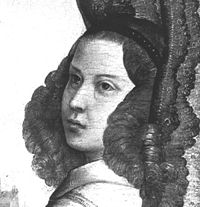 | Born in 1478, Juan was the only surviving son of Isabella and Ferdinand. Juan was married to the Archduchess Margaret of Austria in April of 1497. The couple were very happy, but Juan had never been strong ond he died on 4th October 1497 at the age of nineteen, probably of tuberculosis. Margaret was pregnant when he died but gave birth to a stillborn daughter a few months later. After the premature death of her second husband, the Duke of Savoy, Margaret refused to remarry, although Henry VII was one of her suitors. She became Regent of Burgundy and died in 1530. |
Joanna Queen of Castille,leon....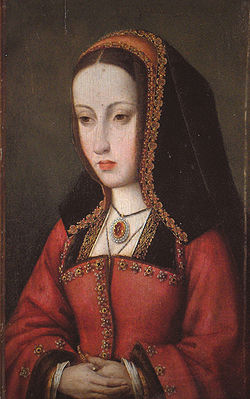 | Born in 1479, Juana was the second daughter of Isabella and Ferdinand. Juana was married to the Archduke Phillip the Handsome, a Habsburg, Duke of Burgundy and heir to the Emperor Maximilian. They had six children: the Emperor Charles V; the Emperor Ferdinand I; Mary Queen of Hungary; Isabella Queen of Denmark; Catherine Queen of Portugal; and Eleanor Queen of Portugal and France. When Isabella died, Juana was to become Queen of Castile. However, Juana's erratic behaviour convinced many that she was mentally unstable and when Isabella died, her Will stated that in the event that Juana was 'absent from Spain or unwilling or unable to govern', her father would serve as Regent of Castile until her son Charles reached the age of twenty. Although he had frequently declared Juana mad, Philip was unwilling to accept the Will, and he and Juana travelled to Spain. On the way, they were shipwrecked in England, where the young Prince Henry was impressed by the Archduke and his father the King was attracted to Juana. The support that Phillip garnered from much of the Castilian nobility, who saw him as a weak ruler who would allow them to increase their own power at the Crown's expense, forced Ferdinand to withdraw to Aragon and thence to Naples. However, Philip died suddenly and rather suspiciously on 25th September 1506. Juana, who was pregnant with her sixth child, Catherine, sunk into a state of torpor and refused to govern. Ferdinand returned from Naples in July 1507 and resumed the reins of government\; officially titled 'Governor', he was king in all but name. Henry VII wished to marry Juana, and negotations continued for some years. Juana retired to Arcos and then to the Castle of Tordesillas, where she remained in captivity until her death. After Ferdinand's death in 1516, Charles travelled to Spain, where he was allowed to take the title of King, although he officially reigned with his mother. Juana remained imprisoned in Tordesillas, increasingly gripped by mental illness - probably bi-polar disorder. Juana would outlive all her siblings. She died in 1555, attended in her last hours by her great-nephew St. Francis Borgia |
Maria of Aragon, Queen consort of Portugal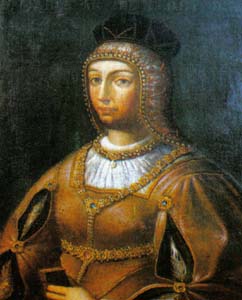 Alonso of Aragon, Queen Katharine's brother 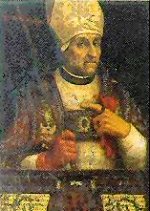 Photograph of the Cathedral of Zaragoza (formerly Saragossa), Aragon 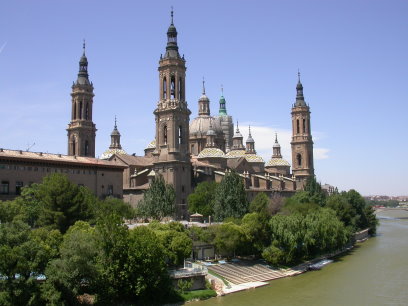 | Born 1482, Maria was the third daughter of Isabella and Ferdinand. She was one of twins, the other twin being stillborn. After her sister Isabella's death in 1498, Maria was wedded to Isabella's widower, Manuel I of Portugal (30th October 1500). Maria and Manuel had ten children, eight of whom survived to adulthood, including the next King, John III, the Empress Isabella, wife of Charles V, and Prince Luis, who was a suitor for the hand of his cousin Mary Tudor. Maria died in 1517. Besides the four siblings shown above, Katharine had numerous half-brothers and sisters, the progeny of her father's frequent affairs Alonso of Aragon (1469 - 1520) was the son of Ferdinand by his mistress Aldonza Roig. This relationship, which initially predated the King's marriage, seems to have been more serious than the others - Aldonza, a Catalan noblewoman, disguised herself as a man in order to be with her lover during the Catalan civil war. Pope Sixtus IV was outraged at Ferdinand's attempt to appoint his son Archbishop of Saragossa at the age of six, but eventually caved in and allowed the appointment when Alonso was nine. Alonso was a typical Renaissance prelate - he had a long-term mistress, Anna de Guerrea, by whom he had six children, and he was a noted patron of the arts and learning, who carried out extensive building works at the Cathedral of Saragossa. He was more interested in politics than religion, and served as Viceroy (Governor) of Aragon from 1486 to 1512 and of Catalonia from 1512 to 1516. He became Regent of the Aragonese kingdoms for his nephew Charles V on his father's death and held this post until his own death in 1520. Two of his sons succeeded him as Archbishop. One of his daughters, Joanna, married Juan Borgia, Duke of Gandia and grandson of Pope Alexander VI, and was the mother of Saint Francis Borgia, head of the Jesuit order. Katharine's other half-siblings included: Joanna of Aragon (c.1468 - 1511). Ferdinand's daughter by Joanna Nicolau of Tarrega, Catalonia, Joanna was educated in Barcelona. A famous beauty, she was considered as a bride by James IV of Scotland, but he was unwilling to accept her because of her illegitimacy. She married Bernard Velasco, Duke of Frias and Constable of Castile, by whom she had a daughter, Juliana-Angela. Alonso de Estrada (c.1476 - c.1535). Son of Ferdinand and Luisa Estrada, who was probably one of the Queen's ladies in waiting, Alonso served as a soldier before going to the Americas as Treasurer of New Spain (Mexico). He served for several terms as Governor of Mexico. Numerous descendants surivive in Mexico and the southern U.S. Maria Esperanza (Mary Hope) (1477 - 1548). Mary-Hope, Ferdinand's daughter by his Basque mistress Toda de Larrea, was brought up in Madrigal, Castile, and became a nun at the local convent. She seems to have been a lady with a genuine relgious vocation, as she turned down the chance of marriage with an Italian nobleman in 1513. She rose to the position of Abbess at Matrigal and at Burgos, and was close to her nephew Charles V, who often turned to her for spititual giuidance. Mary (1479 - 1510), mother unknown, a nun at Valencia. Maria Blanca (Mary Blanche) (c.1483 - 1535). Daughter of a Portuguese lady, Ines de Perreira, Maria joined her half-sister at the convent at Madrigal as a young girl. She also turned down the chance to marry and served as Abbess at Madrigal and at Pedrables in Barcelona. Michael Fernandez (1495 - 1575). Said to be Ferdinand's son by a a Moorish convert, Ayesha Abdullah,he was known as the 'Knight of Granada'. Juan (c. 1500 - ?), mother unknown, who became a soldier. There were also widespread rumours in both Spain and Italy that Ramon Cardona (1467 - 1522), Viceroy of Naples, was an illegitimate son of Ferdinand by Castellana Cardona. Although he usually acknowledged and provided for his offspring, the power and wealth of the Catalan Cardona family would have been a good reason for allowing Ramon to pass as the legitimate son of his mother's husband. As Cardona was one of the few people that Ferdinand trusted and he made a point of confirming his viceroyalty in his Will, the rumour may well have been true. |
Mary I, Queen of England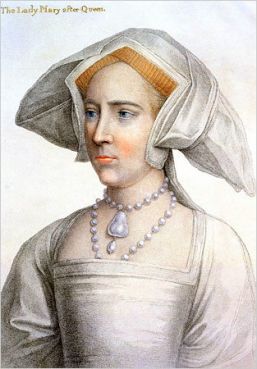 | Katherine's Daughter Mary I of England |
King Henry VIII of England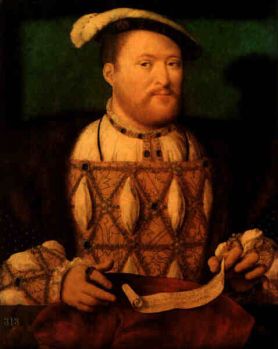 | Katherine's Husband Henry VIII |
Paternal Grandparents of Katherine of Aragon
Maternal Grandparents of Katherine of Aragon
